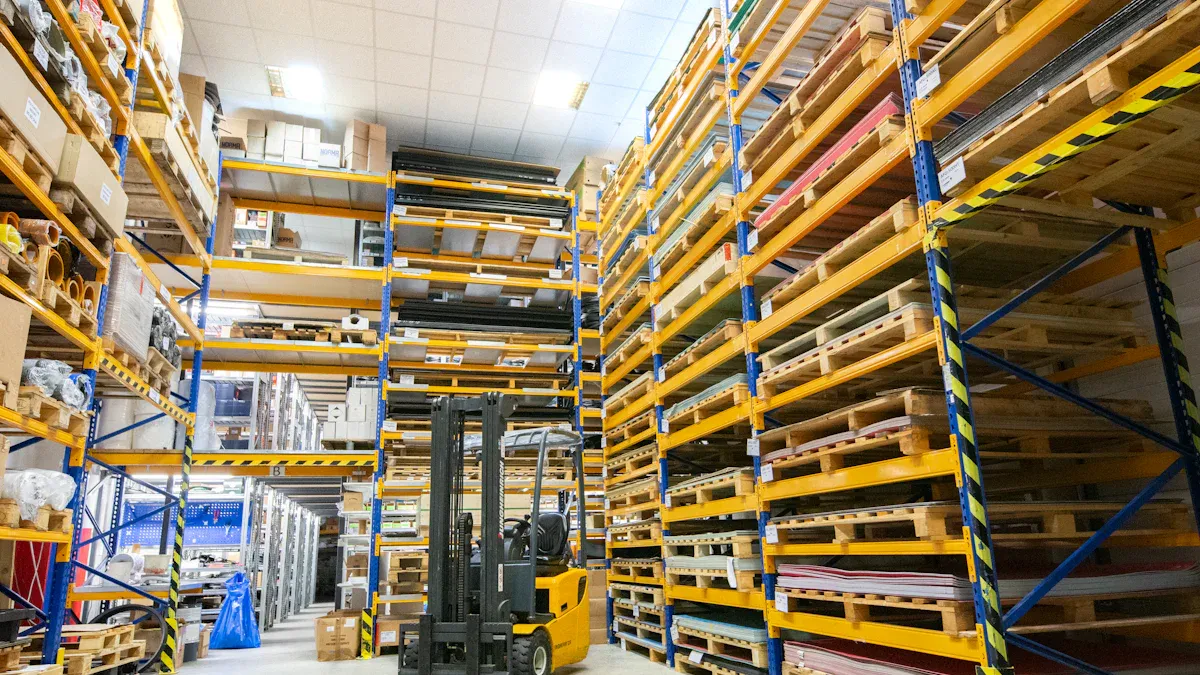
You experience the power of digital transformation when you implement smart shelf technology in your operations. With smartshelf solutions, you gain real-time inventory visibility and automation, which drive efficiency and accuracy. Smart shelves use IoT sensors, ESL Gateway AP, and Electronic Shelf Labels to eliminate manual audits and help you respond quickly to stockouts. Esl Retail environments benefit from AI-powered monitoring, ESL Price Tag updates, and data-driven insights that reduce costs and improve inventory management. This technology empowers you to optimize placement, prevent losses, and stay ahead in a fast-changing market.
Smartshelf Technology: Redefining Inventory Management
What Makes Smart Shelves Intelligent
Core Features and Capabilities
You gain a competitive advantage when you use smart shelf technology. Smart shelves deliver real-time data utilization, allowing you to monitor inventory trends, competitor pricing, and customer preferences. With this technology, you can track up to 17 real-time metrics, including click-through rates, conversions, and social sentiment. You benefit from features such as automatic low-stock alerts, theft detection, and dynamic pricing adjustments. These capabilities help you optimize product placement and ensure that inventory levels remain accurate across all channels. Electronic shelf labels update pricing instantly, keeping your store competitive and responsive to market changes. When you integrate smart shelves, you also enable omni-channel inventory syncing, which prevents stockouts and confusion for your customers.
Differences from Traditional Shelving
Traditional shelving cannot match the intelligence and automation of smart shelf technology. You rely on manual audits and periodic checks with conventional shelves, which often leads to errors and delays. In contrast, smart shelves use sensors and electronic shelf labels to provide continuous, automated updates. The following table highlights how smart shelf technology outperforms traditional and other advanced systems in key areas:
| Technology | Accuracy | Estimated Cost (USD) | Spatial Resolution | AI Embedded |
|---|---|---|---|---|
| EPC | 95% | 200,000* | <20 mm | No |
| RFID | 93% | 173,000* | 10 mm | No |
| GPS | 60% | 200,000* | 5–10 m | No |
| Computer Vision | 98% | 200,000 | 20 mm | Yes |
| Piezo-capacitive Sensors | 73% | 125,000 | N/A | No |
| Interactive Shelving System | 99.2% | 50,000# | 5 mm | Yes |
*Costs assume a retail store with 10,000 items including manpower for tagging and implementation.
#Costs assume sensor mats at USD 100 each, accommodating 20 SKUs per mat.
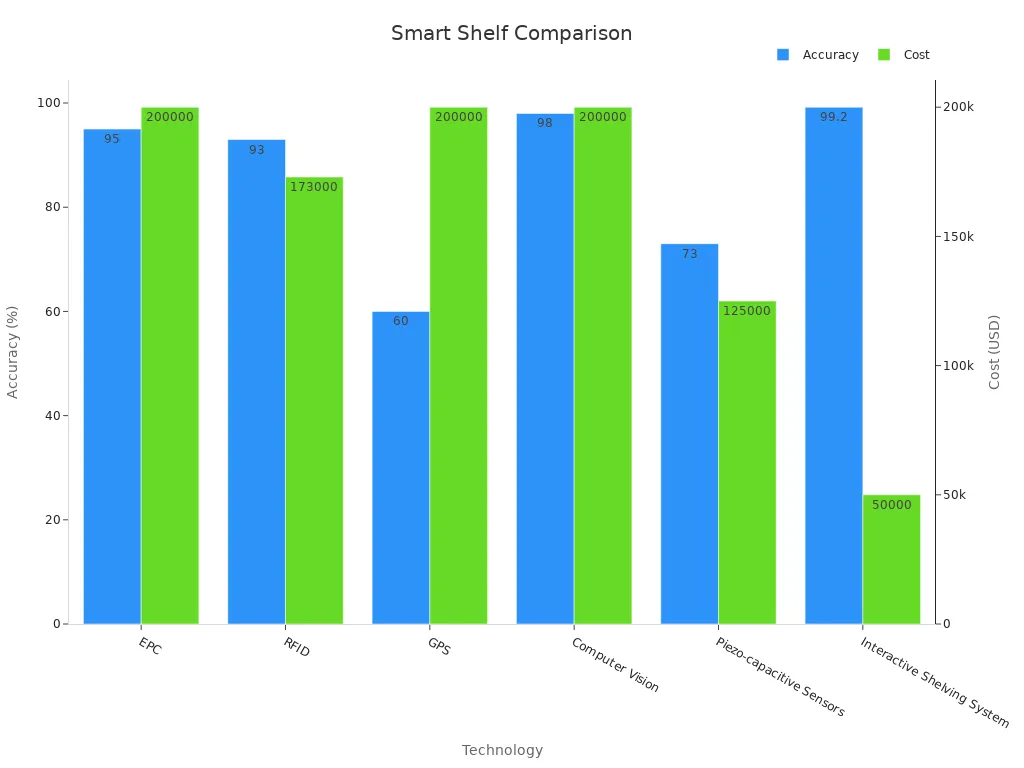
You see that interactive shelving systems, a form of smart shelf technology, offer the highest accuracy and cost efficiency, with advanced AI capabilities that traditional shelves lack.
Key Components of Smart Shelf Technology
IoT Sensors and RFID Integration
Smart shelves rely on a network of sensors and RFID tags to deliver precise, real-time inventory tracking. You benefit from the integration of microcontroller units, power management modules, and RF transceivers, which work together to sense and communicate product status. These components allow you to detect misplaced items, monitor stock levels, and automate replenishment. The use of the internet of things ensures that every product movement is captured and reported instantly. Electronic shelf labels, powered by these sensors, display accurate pricing and inventory data at all times.
Connectivity and Data Platforms
You connect your smart shelves to powerful data platforms that aggregate and analyze information from every shelf and product. These platforms use cloud-based analytics to provide actionable insights, helping you make informed decisions quickly. With seamless connectivity, you can synchronize inventory data across multiple locations and channels. This integration supports real-time reporting, trend analysis, and performance monitoring. As a result, you streamline your inventory management processes and reduce the risk of errors or stock discrepancies.
Tip: By leveraging smart shelf technology, you can transform your operations, reduce costs, and enhance the customer experience through automation and data-driven insights.
Breakthrough Innovations in Smart Shelf Technology
Real-Time Inventory Tracking and Data Accuracy
RFID and Sensor-Based Monitoring
You can transform how you track and manage inventory by leveraging RFID and sensor-based monitoring. Smart shelf technology uses IoT devices and RFID tags to provide continuous, real-time monitoring of every item on your shelves. This approach allows you to identify misplaced products, monitor expiration dates, and receive instant updates on stock movement. Scientific studies show that RFID-equipped shelves increase inventory accuracy from 70% to 98%, which can drive a 5% sales growth. You benefit from real-time inventory tracking, which enables you to prioritize older items and minimize waste. Retailers using RFID technology report inventory accuracy rates between 95% and 99%, compared to only 70% to 75% with traditional systems. These improvements help you reduce errors and improve customer satisfaction.
Automated Stock Level Updates
Smart shelves automate stock level updates, eliminating the need for manual counts. You receive instant notifications when inventory drops below set thresholds, allowing you to reorder products before stockouts occur. Automated systems identify 90% more hidden stockouts and reduce inventory balance errors by 27%. You can also process transactions faster, with automated checkout systems operating up to eight times quicker than manual methods. The following chart highlights key inventory metrics that demonstrate the impact of smart shelf technology:
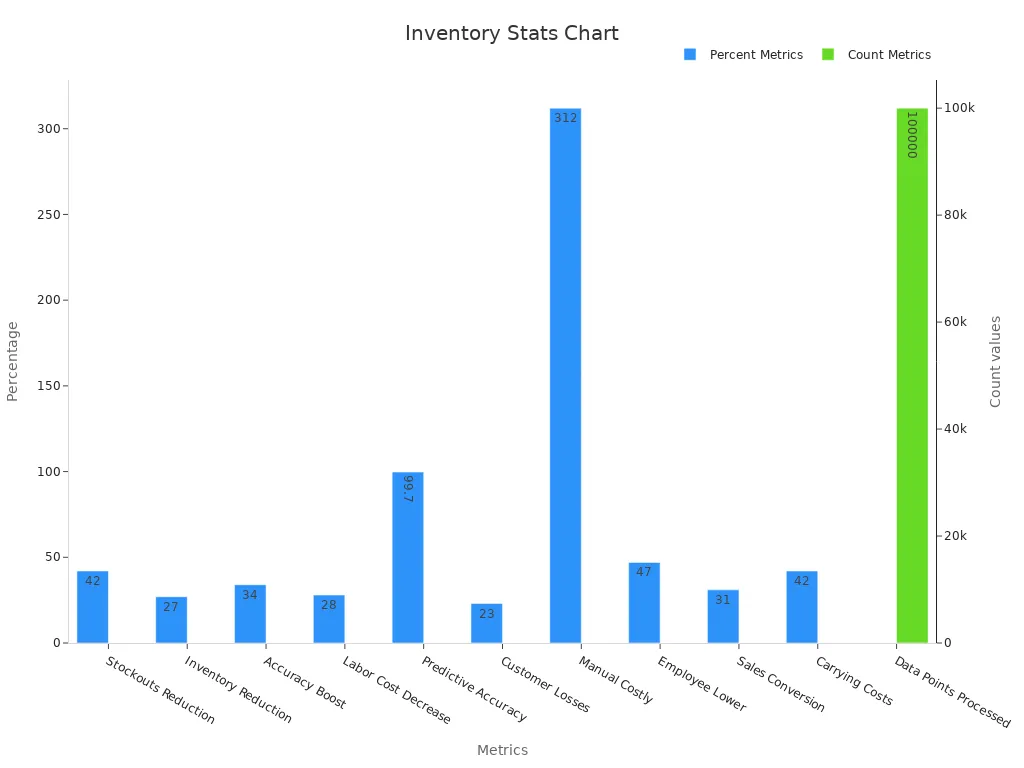
Automated Alerts and Proactive Notifications
Out-of-Stock and Replenishment Alerts
You gain a significant advantage with automated alerts that notify you of low stock or out-of-stock situations. These alerts enable you to track and manage inventory proactively, ensuring timely replenishment and preventing lost sales. Real-time monitoring combined with automated notifications helps you maintain optimal stock levels and avoid costly disruptions. Automated alerts also support predictive analytics, allowing you to set accurate reorder points and flag slow-moving items.
Loss Prevention and Security
Smart shelf technology enhances loss prevention by providing instant alerts for unusual activity, such as theft or abnormal usage. You can respond quickly to potential issues, reducing shrinkage and protecting your assets. Alerts also help you control costs by identifying consumption spikes and inefficiencies. Data insights from these alerts support compliance and improve operational efficiency.
Integration with Digital and Cloud Systems
ERP and Inventory Management Software
You can integrate smart shelves with ERP and inventory management software to streamline your workflow. This integration consolidates data from multiple sources, giving you a unified view of your operations. Automated alerts and real-time monitoring ensure that your inventory data remains accurate and up to date, supporting better decision-making.
Cloud-Based Analytics and Reporting
Cloud-based analytics platforms process vast amounts of data from your smart shelf technology. You gain actionable data insights that help you optimize inventory, allocate labor efficiently, and improve store performance. These platforms enable you to track and manage inventory across locations, reducing manual effort and increasing accuracy. Market projections estimate that smart retail technologies will reach $177.90 billion by 2031, highlighting the growing impact of these innovations.
Note: By adopting smart shelf technology, you position your business to benefit from advanced monitoring, automation, and data-driven decision-making.
Smart Shelves Transforming Retail
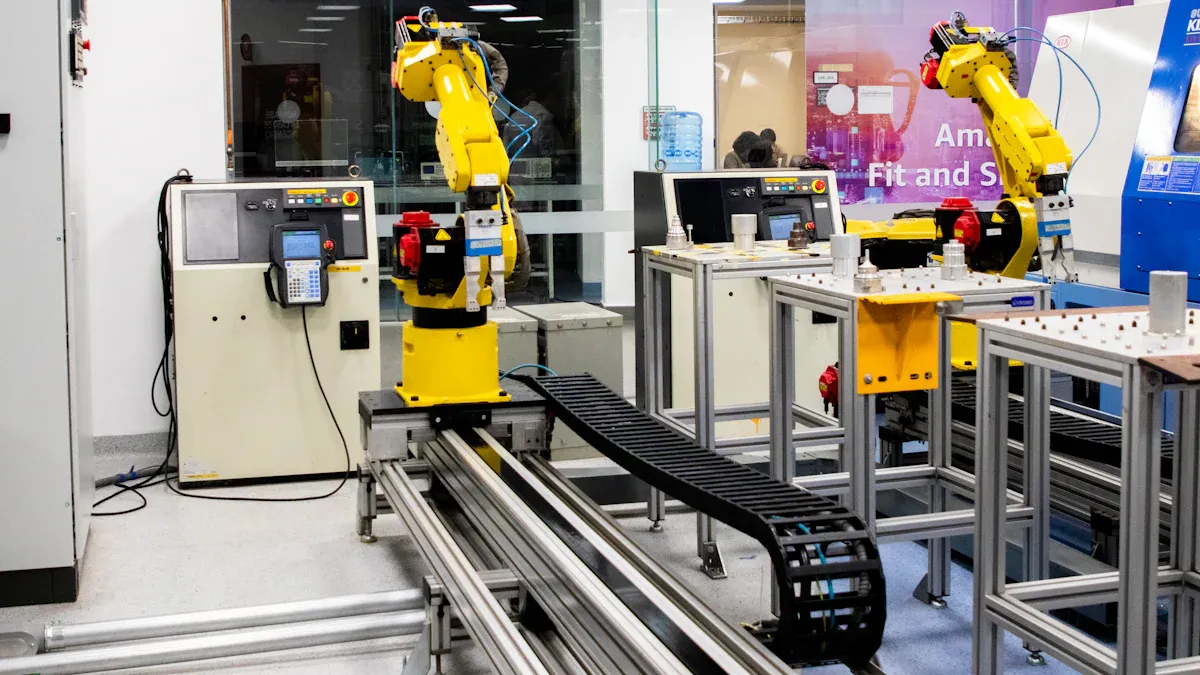
Optimizing Store Performance and Operations
Streamlined Restocking and Inventory Control
You can transform your store’s efficiency by adopting smart shelves. These systems use sensors, RFID tags, and IoT connectivity to deliver real-time data on inventory and consumer behavior. You gain instant visibility into stock levels, which allows you to automate restocking and maintain optimal product availability. Industry reports show that smart retail solutions bridge the gap between physical and digital shopping, supporting a seamless omnichannel experience. When you implement smart shelves, you reduce manual labor and minimize errors, which leads to faster and more accurate inventory control.
| Metric Description | Numerical Evidence |
|---|---|
| Sales uplift through assortment optimization | 2% to 8% |
| Incremental sales on targeted promotions | 5 percentage points |
| Incremental revenue through monetization | 0.5% to 2% |
| Time reduction for building product mixes | 50% |
| Increase in promotions profitability | 15% to 30% |
| Productivity gain on category management | 50% to 70% |
These figures highlight how smart retail technology drives measurable improvements in store operations and profitability.
Reducing Shrinkage and Human Error
You can address shrinkage and human error by leveraging smart shelves. Automated tracking detects product removal instantly, which helps you prevent theft and loss. RFID and IoT integration enable you to monitor inventory with high accuracy, reducing discrepancies and supporting compliance. As you automate these processes, you free up staff to focus on customer service, which further enhances store performance.
Enhancing Customer Experience and Engagement
Ensuring Product Availability
You ensure that your customers always find what they need by using smart shelves. Real-time stock data reduces out-of-stock situations, which improves shopping convenience and satisfaction. Smart retail systems deployed in over 20 million units globally—70% in supermarket chains—demonstrate the scale and impact of this technology.
Personalized Shopping and Dynamic Pricing
You can personalize the shopping journey with smart shelves. These systems use digital labels and AI to deliver targeted promotions and dynamic pricing, which respond to real-time demand and inventory. Customers receive personalized recommendations and deals, which increase engagement and drive sales. Smart retail innovations also support interactive features, such as touch screens and AR, that enhance the customer experience.
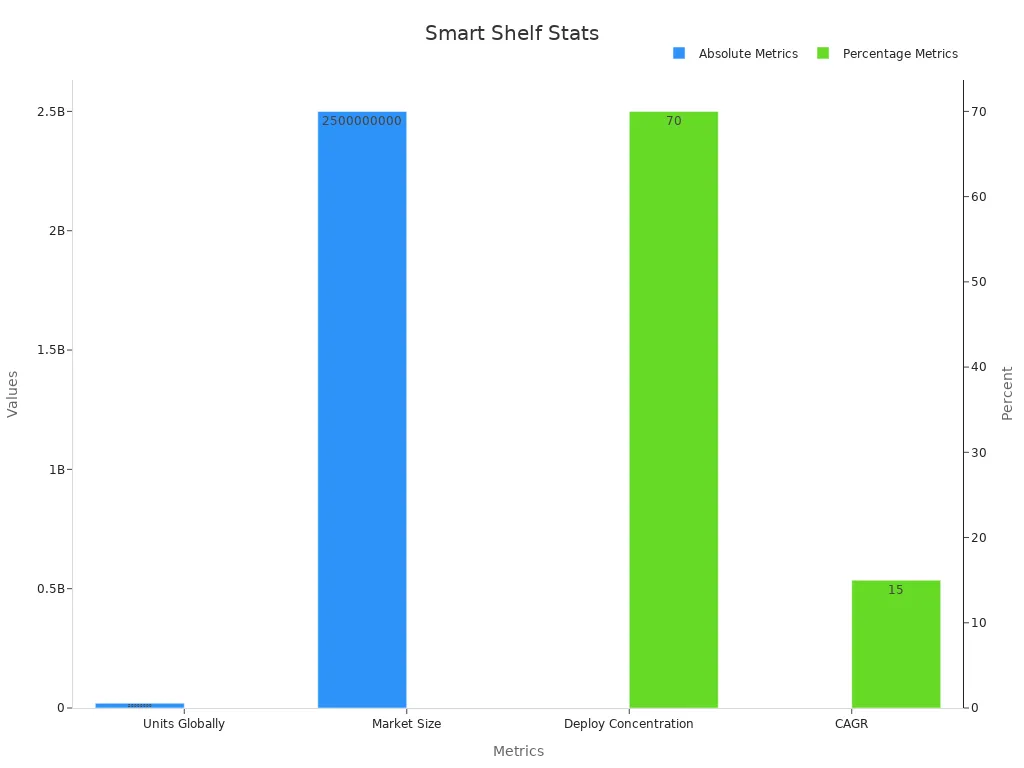
Real-World Retail Smartshelf Applications
Case Study: Major Supermarket Chain
You see leading supermarket chains like Walmart using AI-powered shelf-scanning robots to track stock levels in real time. These innovations enable precise replenishment planning and waste reduction, especially for fresh items. Ahold Delhaize has deployed over 3 million electronic shelf labels, updating prices remotely within 80 minutes and automating markdowns for near-expiry products. These advances optimize supermarket operations and improve the customer experience.
Case Study: Specialty Retailer
Specialty retailers such as Sephora use AI-driven computer vision and chatbots to personalize shopping, making product discovery easier and boosting purchase confidence. Macy’s leverages RFID tags to improve inventory visibility and theft prevention, while GetGo uses digital smart screens to provide real-time pricing and nutritional information. These smart retail solutions create engaging, automated retail stores that respond to evolving consumer behavior.
Smart Shelf Technology in Libraries
Automating Book Tracking and Management
Real-Time Location and Self-Service Returns
You can transform library operations by using smart shelf technology for real-time book tracking. RFID tags and IoT sensors allow you to locate any item instantly, reducing the time spent searching for misplaced books. When you implement self-service kiosks, you enable patrons to return books quickly and securely. RFID technology processes multiple items at once, so users do not need to scan each book individually. Libraries like the National Library Board of Singapore and Lied Library at the University of Nevada have demonstrated that RFID systems can check out entire stacks of books within seconds. This automation streamlines returns and reduces staff workload.
Improved Collection Management
You improve collection management by integrating smart shelving with electronic shelf labels and labeling systems. These tools display real-time information about each item, including availability and location. You can update hundreds of labels remotely in minutes, which helps you keep your catalog accurate and up to date. Mobile shelving and cantilever shelving maximize storage by adjusting to different book sizes and formats. These systems also enhance safety with anti-tip mechanisms and aisle locks. When you use smart lockers, you provide secure, contactless storage for patrons and automate material exchanges, further optimizing library space.
Tip: Proper planning and durable materials ensure your shelving supports collections safely and efficiently.
Enhancing Library User Experience
Faster Book Retrieval
You deliver faster book retrieval by using RFID and electronic shelf labels. These technologies reduce the need for manual catalog searches and help users find books quickly. Shelf-scanning time drops because you can identify misplaced items with ease. Libraries that use self-service kiosks report that up to 97% of patrons adopt self-checkout, freeing staff to focus on research assistance and programming. This shift supports a modern library atmosphere and meets user expectations.
Streamlined Check-In and Check-Out
You streamline check-in and check-out processes with RFID-enabled kiosks. Patrons can process multiple items at once, which speeds up circulation and reduces lines. Aurora Public Library District reports that 88% of patrons use self-checkout, allowing staff to dedicate more time to valuable services. Cloud-based software manages locker usage and automates reporting, ensuring a full chain of custody for borrowed materials. Automation reduces manual tracking errors and supports efficient inventory management.
Real-World Library Smartshelf Examples
Case Study: University Library
You see the impact of smart shelf technology at Lied Library, University of Nevada. By integrating RFID, the library enables entire stacks of books to be checked out in seconds. This system improves operational efficiency and enhances the user experience by minimizing wait times and manual processing.
Case Study: Public Library System
Park Ridge Public Library implemented RFID self-service kiosks, leading to rapid adoption of self-checkout by patrons. Within three months, 90% of users chose self-service, and this number grew to 97%. Staff workload decreased, and patrons enjoyed a smoother, more efficient visit. Smart lockers and cloud-based management further improved space utilization and security for both materials and personal belongings.
Smartshelf Solutions in Logistics and Warehousing
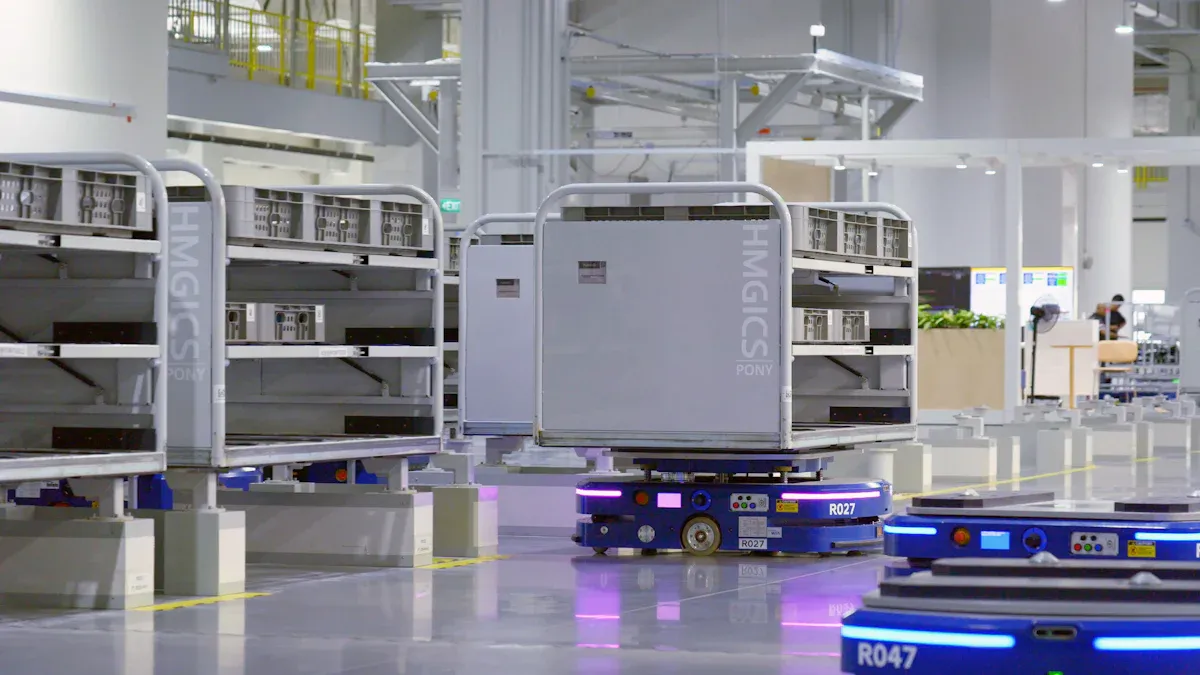
Optimizing Inventory Flow and Space Utilization
Automated Picking and Packing
You can transform your warehouse operations by implementing smart shelves that use IoT, RFID, and bar-coding technologies. These systems provide real-time inventory tracking, which gives you immediate visibility into stock levels. You make rapid, data-driven decisions that prevent overstocking or stockouts. Smart shelves support batch and zone picking, which streamlines order fulfillment and reduces downtime. When you use solutions like UNEX’s SpanTrack Lane and SpanTrack Wheel Bed, you gain flexible storage that adapts to different carton sizes and SKU turnover rates. This adaptability improves product movement and supports high-efficiency picking and packing. In cold chain monitoring, you benefit from precise tracking of temperature-sensitive goods, ensuring product integrity throughout the supply chain.
Dynamic Space Management
You maximize warehouse space by organizing products based on usage frequency and employing adjustable racks and vertical storage. Smart shelves help you optimize layout, which allows you to store more items without expanding your footprint. Cold chain monitoring becomes more reliable when you use these systems, as you can track and manage perishable goods in real time. You reduce wasted space and improve access to high-turnover products, which boosts overall efficiency. Companies like DHL have reported a 15% increase in productivity after adopting smart warehousing technologies, with order-picking efficiency improving by 25% in augmented reality trials. Coca-Cola HBC also achieved faster picking speeds and higher accuracy, which led to better customer satisfaction and fewer returns.
Reducing Operational Costs and Errors
Labor Savings and Efficiency
You lower operational costs by automating manual stock checks and enabling data-driven product placement. Smart shelves reduce the need for labor-intensive audits, which frees your staff for higher-value tasks. Regression analysis shows that smart logistics technology, including smart shelves, significantly reduces transaction costs and improves logistics efficiency. The coefficient for reducing transaction costs is 0.368, and for improving logistics efficiency, it is 0.485—both statistically significant. Cold chain monitoring further enhances efficiency by automating compliance checks and reducing spoilage.
Minimizing Stockouts and Overstocks
You minimize stockouts and overstocks by leveraging real-time data from smart shelves. These systems achieve an average 79% accuracy in correctly associating products across locations, which reduces tracking errors and improves inventory management. The following table highlights the accuracy of smart shelf systems in logistics environments:
| Run | Duration | Items with Cross-Location | Items Correctly Identified | Percent Correct Association |
|---|---|---|---|---|
| 1 | 30 min | 5 | 5 | 100% |
| 2 | 30 min | 2 | 2 | 100% |
| 3 | 30 min | 5 | 3 | 60% |
| 4 | 30 min | 4 | 3 | 75% |
| 5 | 60 min | 5 | 3 | 60% |
| Average | 79% |
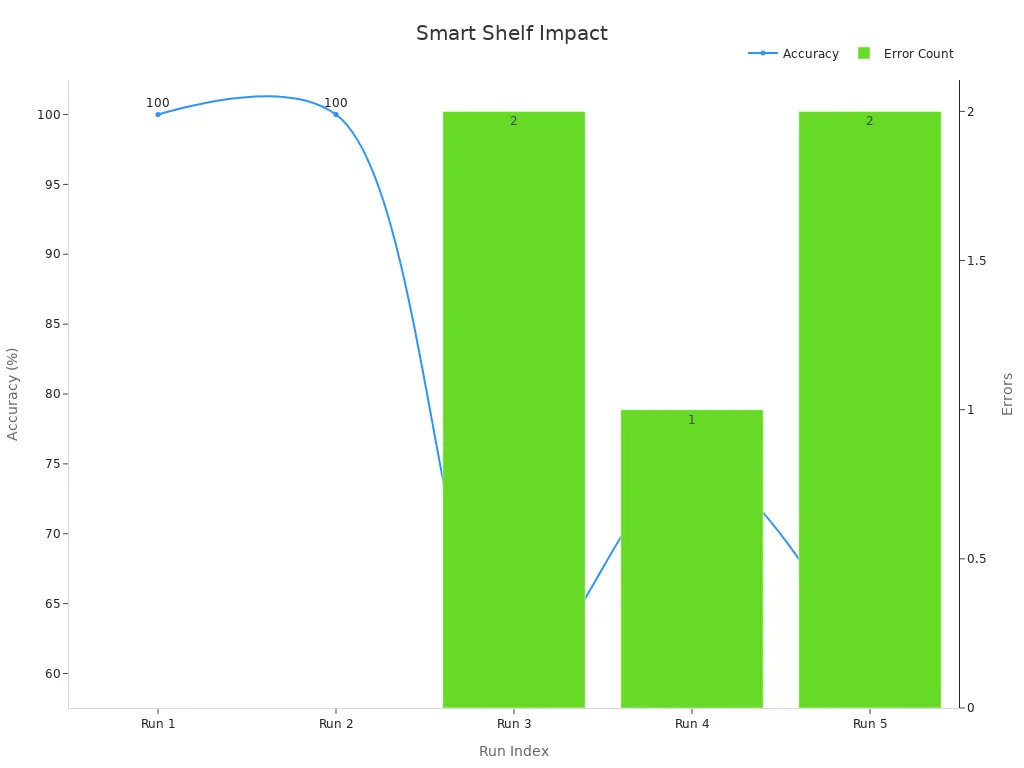
You see that these improvements directly impact supply chain management by reducing costly errors and ensuring products reach their destinations efficiently. Cold chain monitoring also plays a critical role in preventing losses from temperature excursions.
Real-World Logistics Smartshelf Implementations
Case Study: E-Commerce Fulfillment Center
You can look to leading e-commerce fulfillment centers for examples of smart shelf success. IoT-based warehouse management systems have reduced air shipping time by 54%, which accelerates delivery and improves customer satisfaction. Inventory accuracy improved from 98% to 99.52%, and customer complaints dropped by 11%. RFID smart tags saved up to 99% of the time spent on joint ordering operations, which increased operational efficiency. Cold chain monitoring in these environments ensures that perishable goods remain safe and compliant throughout the process.
Case Study: Third-Party Logistics Provider
Third-party logistics providers have adopted smart shelves and Bluetooth indoor positioning systems to improve stock time, delivery time, and tracking efficiency. Cross-docking operations saw up to a 91% boost in total operation time, which enhanced throughput and reduced handling time. Major companies such as Alibaba, DHL, Amazon, and Bluedart have implemented these solutions, demonstrating their scalability and effectiveness. Cold chain monitoring remains a top priority, as these providers must guarantee the quality and safety of temperature-sensitive shipments.
Tip: By integrating smart shelves and advanced cold chain monitoring, you can achieve higher efficiency, lower costs, and greater reliability in logistics and warehousing.
Measurable Impacts of Smart Shelves
Efficiency and Productivity Gains
Faster Inventory Audits
You experience a dramatic shift in how you conduct inventory audits when you implement smart shelves. Traditional audits often require hours of manual scanning and counting. With smart shelf technology, you automate these processes and access real-time data at your fingertips. Companies that invest in smart factory solutions, including smart shelves, report a 10% to 12% average increase in manufacturing output and labor productivity. New adopters typically see an initial 4% boost in labor productivity after implementation. These gains come from technologies that sense quality, automate conveyance, and provide asset intelligence. You reduce disruptions and keep your operations running smoothly.
- You can expect more than a 3% annual increase in labor productivity after adopting smart technologies.
- 86% of manufacturers believe these initiatives will drive competitiveness within five years.
- Productivity gains often result from redeploying labor to higher-value tasks, not layoffs.
Smart shelves help you complete audits faster, minimize downtime, and focus your team on strategic activities.
Reduced Manual Labor
You reduce manual labor significantly by using smart shelves. Automated tracking and real-time updates eliminate the need for repetitive stock checks. Your staff can shift their attention to customer service or process improvement. The efficiency improvements you gain from smart shelf technology benefits your entire operation. You streamline workflows, reduce errors, and create a safer, less physically demanding environment for your team.
Cost Reductions and ROI
Lower Inventory Carrying Costs
You lower your inventory carrying costs by optimizing stock levels and reducing excess inventory. Smart shelves provide accurate, real-time data, which helps you avoid overstocking and understocking. Market analysis projects a compound annual growth rate of more than 5.8% for smart shelf technologies from 2023 to 2030. The market size is expected to exceed $120 billion by 2030, driven by advancements in AI, machine learning, and IoT. These technologies enhance inventory tracking and automation, supporting strong financial returns and cost-effectiveness.
| Benefit Category | Impact on Retail Operations | Example Metrics |
|---|---|---|
| Cost Reduction | Lower holding, labor, and waste costs | 5-10% reduction in overhead |
| Sales Enhancement | Increased customer satisfaction and cross-sell | Up to 20% lift in average basket size |
| Competitive Advantage | Strengthened market positioning | Higher NPS (Net Promoter Score) ratings |
You see that predictive analytics models allow you to forecast demand accurately. You use mathematical formulas to optimize inventory, such as Demand Forecast = α + β1X1 + β2X2 + … + βnXn, where each coefficient represents a key influencing factor. Retailers have reported over 20% reduction in stock-out events and 5-10% savings in overhead costs. You also benefit from up to a 20% increase in average basket size, confirming strong cost reductions and a solid return on investment.
Fewer Lost or Misplaced Items
You minimize lost or misplaced items by leveraging the real-time tracking capabilities of smart shelves. Automated alerts notify you immediately if an item is missing or misplaced. This reduces shrinkage and improves inventory accuracy. You maintain better control over your assets, which leads to fewer write-offs and less waste.
Enhanced Customer and User Satisfaction
Improved Service Levels
You improve service levels by ensuring products are available when customers need them. Smart shelves help you maintain high fill rates and reduce out-of-stock situations. For example, Retail Chain A reduced its out-of-stock rate by 30% after implementing smart shelf solutions. High fill rates mean you meet most customer demand immediately, which boosts satisfaction.
| Metric | Definition | Numerical Indicator / Impact |
|---|---|---|
| Fill Rate | Percentage of customer demand met | High fill rate means most demand is satisfied immediately |
| Out-of-Stock Rate | Frequency of product unavailability | Retail Chain A reduced OOS rate by 30% after smart shelf implementation |
| Stock Turnover Ratio | Frequency of inventory replacement | Indicates inventory efficiency, important in FMCG sectors |
You also see a 15% increase in impulse purchases and a 10% increase in overall sales, as reported by Supermarket Chain B. Even a 1% increase in shelf availability can boost sales by 2% to 3%.
Increased Loyalty and Engagement
You foster greater loyalty and engagement by delivering a seamless shopping or user experience. When customers find what they need without delay, they are more likely to return. Smart shelves support personalized promotions and dynamic pricing, which enhance engagement. Higher Net Promoter Scores reflect improved satisfaction and a stronger competitive position. You build lasting relationships with your customers and users by consistently meeting their needs.
Tip: Smart shelf technology benefits extend beyond operational improvements. You create a more responsive, customer-focused environment that drives loyalty and long-term growth.
The Future of Smartshelf Technology
Emerging Trends and Innovations
AI and Predictive Analytics Integration
You will see artificial intelligence and predictive analytics shape the next wave of smart shelf technology. AI-driven systems help you forecast demand, optimize inventory, and personalize customer experiences. Predictive analytics allow you to anticipate stockouts and automate replenishment before issues arise. As you adopt these tools, you gain deeper insights into shopping patterns and operational bottlenecks. The global market for smart shelves continues to expand as retailers seek to leverage data analytics for competitive advantage. You benefit from real-time recommendations and dynamic pricing, which drive both efficiency and customer satisfaction.
Expansion into New Sectors
Smart shelf solutions now move beyond retail. You find applications in healthcare, logistics, libraries, and even manufacturing. Hospitals use smart shelves to track medical supplies and ensure compliance. Warehouses rely on these systems for automated picking and space optimization. As digital transformation accelerates, you see new industries adopting smart shelf technology to streamline workflows and reduce errors. The following table highlights key market trends and forecasts:
| Aspect | Details |
|---|---|
| Market Size Forecast | Growth from USD 3.59 billion in 2025 to USD 17.93 billion by 2034 |
| CAGR | 19.55% during 2025-2034 |
| Technology Segments | RFID-enabled shelving, weight sensors, camera-based systems, IoT-integrated solutions |
| Key Trends | Automation, IoT, AI, data analytics for inventory management and customer experience |
| Emerging Innovations | Mobile app integration, augmented reality, contactless shopping, sustainability-driven design |
You notice that automation, IoT, and AI remain at the core of these advancements, while new features like augmented reality and mobile integration continue to emerge.
Ongoing Advancements and Challenges
Sustainability and Green Initiatives
You recognize that sustainability now drives many technology decisions. Manufacturers design smart shelves with energy-efficient components and recyclable materials. You see a shift toward cloud-based solutions that reduce hardware waste and energy consumption. Companies focus on green initiatives to meet regulatory requirements and appeal to eco-conscious consumers. As you implement these systems, you contribute to a more sustainable supply chain and reduce your environmental footprint.
Customization, Scalability, and Cost Barriers
You face challenges as you scale smart shelf deployments. High initial costs and integration complexity can slow adoption. You must invest in staff training to ensure effective use of new systems. Customization remains essential, as each industry and organization has unique needs. You may encounter data privacy concerns and digital mistrust, especially when handling sensitive information. To overcome these barriers, you should choose modular solutions that grow with your business and prioritize user-friendly interfaces. Ongoing advancements in IoT and ESL technology help lower costs and improve scalability, making smart shelves more accessible across sectors.
Tip: Start with pilot programs to test scalability and gather feedback before full-scale implementation.
You see smart shelf breakthroughs driving real-time visibility, automation, and actionable insights in inventory management. Organizations in retail, consumer electronics, and FMCG achieve measurable gains. The table below highlights key outcomes:
| Industry Sector | Company Type | Operational Improvement / Cost Saving | Quantitative Outcome |
|---|---|---|---|
| Retail (Global Apparel) | Major Apparel Retailer | Inventory holding cost reduction | 15% reduction |
| Retail (Global Apparel) | Major Apparel Retailer | Profit margin improvement | 10% increase |
| Consumer Electronics | Innovative Tech Firm | SKU portfolio reduction and brand alignment | 30% SKU cut |
| FMCG (Food & Beverage) | Global FMCG Leader | Inventory waste reduction | 20% reduction |
| FMCG (Food & Beverage) | Global FMCG Leader | Improved agility and faster innovation cycles | Qualitative improvement |
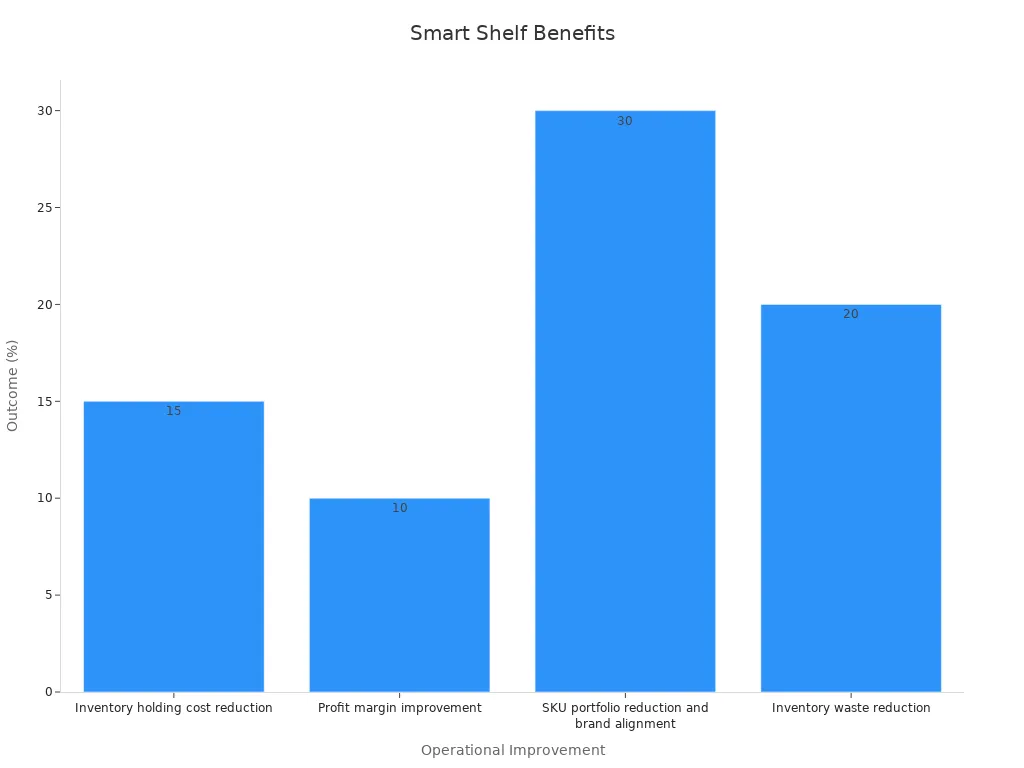
You position your business for greater efficiency, cost savings, and user satisfaction. As innovation advances, smart shelves will shape the future of operational excellence.
FAQ
What is smart shelf technology?
Smart shelf technology uses sensors, RFID, and digital labels to track inventory in real time. You gain instant visibility into stock levels and product locations. This system helps you automate restocking and improve accuracy across your operations.
How do smart shelves reduce manual labor?
You automate inventory tracking and stock audits with smart shelves. The system updates data automatically, so your staff spends less time on repetitive tasks. This shift allows your team to focus on higher-value activities.
Can smart shelves integrate with existing inventory systems?
Yes, you can connect smart shelves to your current ERP or inventory management software. Integration ensures seamless data flow and real-time updates. You maintain a unified view of your inventory across all channels.
What industries benefit most from smart shelf technology?
You see the greatest impact in retail, logistics, libraries, and healthcare. These sectors require accurate inventory tracking and efficient space management. Smart shelves help you optimize workflows and reduce errors in these environments.
How do smart shelves improve customer experience?
You ensure products remain available and easy to find. Smart shelves support dynamic pricing and personalized promotions. You also provide faster service and better information, which increases satisfaction and loyalty.
What are the main challenges in adopting smart shelf solutions?
You may face high initial costs, integration complexity, and the need for staff training. Customization and scalability can also present challenges. Careful planning and pilot programs help you address these issues.
How does customer support work with smart shelf systems?
You receive customer support through dedicated service teams, online resources, and training materials. Support teams assist you with installation, troubleshooting, and ongoing maintenance. This ensures your smart shelf system operates smoothly.


